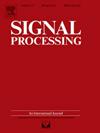Cramér–Rao Lower Bound of adaptive filtering algorithms for acoustic echo cancellation
IF 3.4
2区 工程技术
Q2 ENGINEERING, ELECTRICAL & ELECTRONIC
引用次数: 0
Abstract
Numerous adaptive filtering algorithms have been proposed for acoustic echo cancellation. However, whether the performance of the algorithms approaches the optimal performance or if there has been intentionally overstated remains challenging to evaluate. Fortunately, the Cramér–Rao Lower Bound (CRLB) provides a theoretical minimum variance for any unbiased estimator under given observational data and statistical models. This paper derives the CRLB of adaptive filtering algorithms for acoustic echo cancellation (AEC), in which the generalized Gaussian distribution (GGD) is utilized to model the Gaussian/non-Gaussian background noises. To accelerate the CRLB calculation process, the recursive resolution of the CRLB is presented by using the matrix inversion lemma, and the computational complexity is also analyzed. The derivation results indicate that CRLB for AEC model depends on the acoustic input (i.e., speaker’s voice) and the statistical properties of GGD noise but is unaffected by the channel sparsity. The CRLB derived in this paper can serve as a benchmark to evaluate whether the performance of the adaptive filtering algorithms is optimal and to exclude some adaptive filtering algorithms that deliberately exaggerate their performance.
声学回波抵消自适应滤波算法的cram - rao下界
许多自适应滤波算法被提出用于声学回波消除。然而,这些算法的性能是否接近最佳性能,或者是否被故意夸大,仍然具有挑战性。幸运的是,在给定的观测数据和统计模型下,cram - rao下限(CRLB)为任何无偏估计量提供了一个理论上的最小方差。本文提出了基于广义高斯分布(GGD)对高斯/非高斯背景噪声进行建模的自适应声回波抵消(AEC)算法的CRLB。为了加快CRLB的计算速度,利用矩阵反演引理给出了CRLB的递归解析,并分析了计算复杂度。推导结果表明,AEC模型的CRLB取决于声输入(即说话人的声音)和GGD噪声的统计特性,但不受信道稀疏性的影响。本文推导的CRLB可以作为评价自适应滤波算法性能是否最优的基准,排除一些故意夸大其性能的自适应滤波算法。
本文章由计算机程序翻译,如有差异,请以英文原文为准。
求助全文
约1分钟内获得全文
求助全文
来源期刊

Signal Processing
工程技术-工程:电子与电气
CiteScore
9.20
自引率
9.10%
发文量
309
审稿时长
41 days
期刊介绍:
Signal Processing incorporates all aspects of the theory and practice of signal processing. It features original research work, tutorial and review articles, and accounts of practical developments. It is intended for a rapid dissemination of knowledge and experience to engineers and scientists working in the research, development or practical application of signal processing.
Subject areas covered by the journal include: Signal Theory; Stochastic Processes; Detection and Estimation; Spectral Analysis; Filtering; Signal Processing Systems; Software Developments; Image Processing; Pattern Recognition; Optical Signal Processing; Digital Signal Processing; Multi-dimensional Signal Processing; Communication Signal Processing; Biomedical Signal Processing; Geophysical and Astrophysical Signal Processing; Earth Resources Signal Processing; Acoustic and Vibration Signal Processing; Data Processing; Remote Sensing; Signal Processing Technology; Radar Signal Processing; Sonar Signal Processing; Industrial Applications; New Applications.
 求助内容:
求助内容: 应助结果提醒方式:
应助结果提醒方式:


